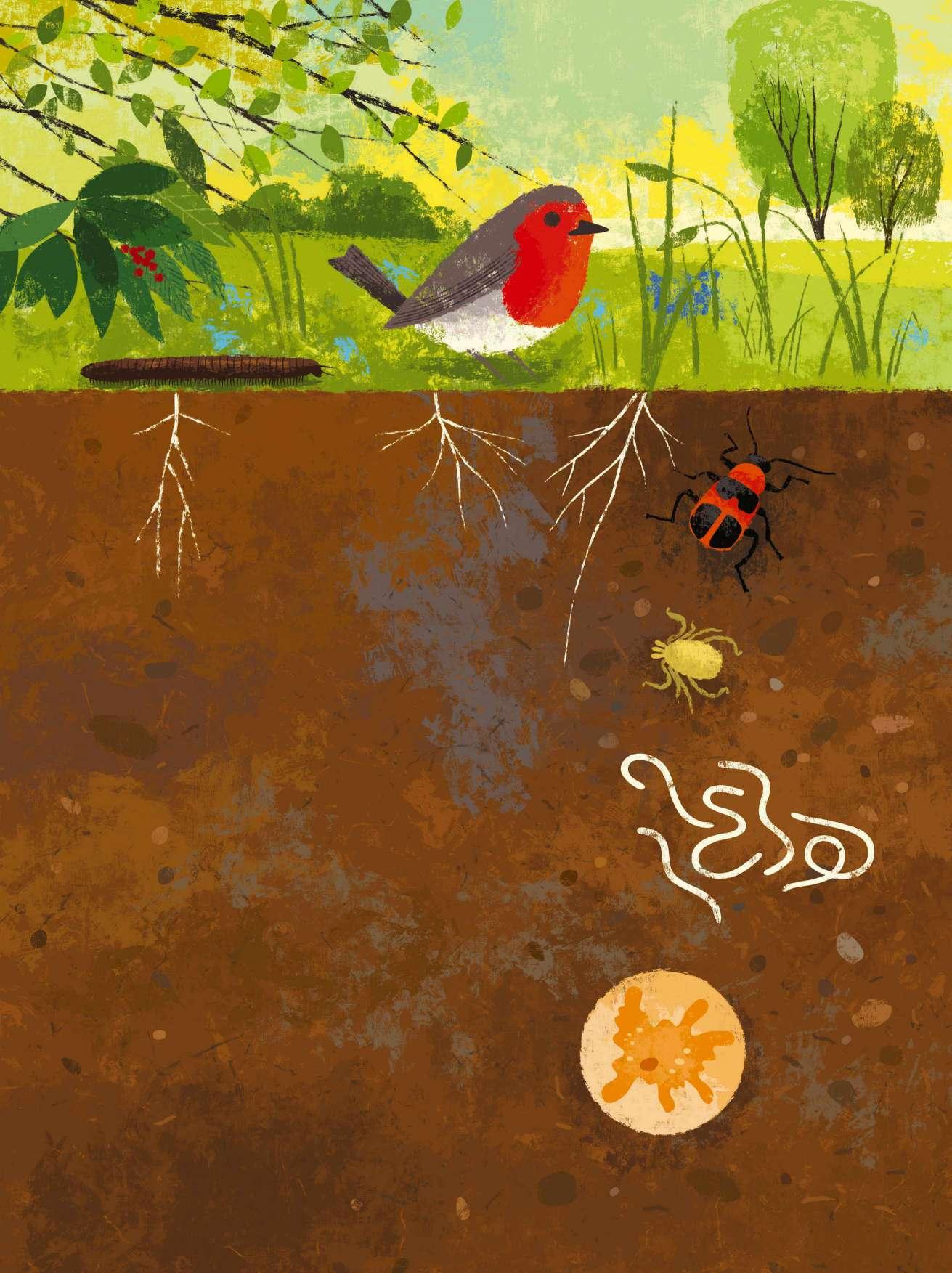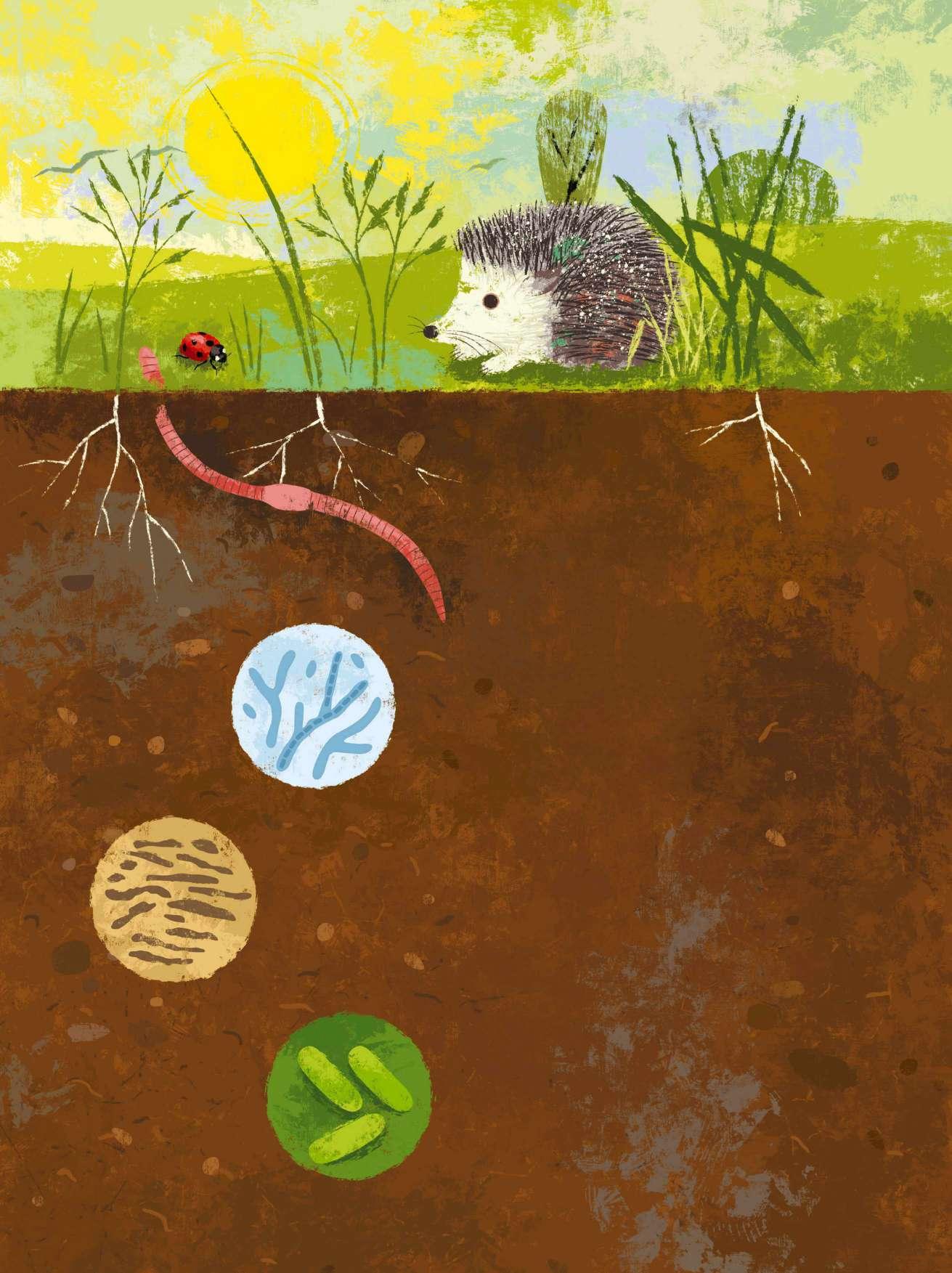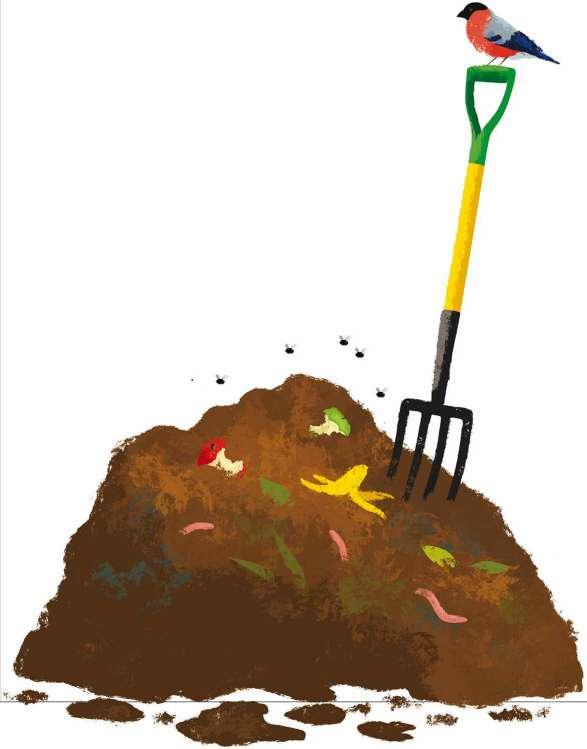
8 minute read
What lies beneath In the first of
WHAT LIES BENEATH
In the first part of a new series, gardener Alys Fowler looks at how we can improve the health of our gardens’ soil by using compost
WORDS ALYS FOWLER ILLUSTRATION MICHAEL CRAMPTON
When we think about our gardens, we tend to think only of what we can see; the bit above. But the garden below is as rich and intricate as anything that grows in the light. The subterranean garden grows deeper than the trees towering above, and has its own fauna, infrastructure and a rich microbial world that works with plant roots to explore, colonise and extend the reach of the world above into the horizons of the world below. Your garden is important for many reasons, but one that has been vastly overlooked is its role in protecting one of our most precious resources: good soil.
Healthy soil has many functions and roles. It provides structure, recycles nutrients for plant growth, purifies water, removes pollutants, regulates carbon storage stocks, and creates habitats and homes. Unlike much of farming land worldwide, our gardens contain potentially highly fertile soils with a resilient and rich biodiversity that is relatively untampered – think of the soil under any perennial, shrub or tree that remains undisturbed, in comparison to a ploughed field.
e soil food web
One of the fundamental aspects of soil ecology is the soil food web. This web encompasses the community of living things that spend all or part of their life in the soil, everything from worms to millipedes to moles and microbes – the billions of bacteria, nematodes, protozoa, actinomycetes and fungi that you can’t see with the naked eye. Past practices and learnings have often
NEMATODES are prolific and mostly beneficial, consuming everything below them in the chain, and some above. ARTHROPODS (mites, spiders, beetles and millipedes) shred organic matter, such as leaves, speeding up decomposition.
PROTOZOA (amoebae, ciliates and flagellates) work with and, mostly, live off bacteria.
EARTHWORMS make casts up to 50 per cent higher in organic matter than surrounding soil.
FUNGI can travel by increasing in length, helping to aerate soil and move nutrients around.

ORGANIC MATTER (autumn leaves, dead stems and plant material, very rough compost) if it decays rapidly, in less than six months, it is an indicator your soil food web is fairly healthy.
BACTERIA are vital to the planet’s health. When bacteria die, the nutrients they recycle become available to plants.
How healthy is your soil?
Even with a microscope it is hard to assess your soil’s population of microbes, which are the major source of nutrient retention and recycling in the soil food web. But there are a few good indicators. • Lots of earthworms indicate good bacterial and protozoan populations because that is what they like to eat. • Fungi, either as strands of white mycelia just below the surface of the soil or fruiting bodies of mushrooms above. • If your soil is a rich brown colour then it is likely to be rich in humic and fulvic acids as well as humus, all essential in helping roots receive water and nutrients. • Black, grey or blue looking soils are anaerobic and often waterlogged, which can indicate poor soil health.
Top tips for improving your soil
• Forget the idea that plants need constant food from outside sources, such as fertilisers, and that the soil is incapable of caring for itself. Be happy with the odd clover or spotted leaf. • Avoid using fungicides on your plants as this will only damage all the beneficial organisms that you are trying to maintain. This goes for pesticides, too, and – as much as possible – herbicides. These also damage the life within the soil in the long run, creating greater problems for your soil and plants. • Instead, build and maintain a healthy population of microorganisms, fungi and bacteria by using sustainable techniques, and allow them to care for your plants as nature intended. • Only walk on soil when absolutely necessary, and use boards to distribute your weight. Compaction is one of the most damaging effects on soil, causing it to become anaerobic and to begin to toxify, killing many of the beneficial microbes. • Avoid over-cultivation, as this will damage the structure of the soil and tear apart the important fungal system established within it. Forget the neat look; instead be happy with the fluffy cake-like texture you get from a healthy soil. • Where possible, opt for bare-rooted plants and plant them at any time of year. This will force the plant to establish quickly and it will be far stronger and healthier for it, but do take special care not to damage the roots. Remove the soil, wash the roots and plant into a hole that is no bigger than necessary. Use the potting soil as a mulch around the base of the plant if you wish.
focused on the few bad ones that cause disease or are considered pests, rather than the vast majority that do the hard work in the garden. It’s this lot that you want to nurture and increase in your soil.
The best way to do this is to feed the soil food web, and compost is one of the easiest ways to start. Well-made compost contains all the soil food web microbes as well as organic matter, which provides both living space and food for these microbes and other soil fauna. There are other ways by which you can feed the soil food web, using liquid feeds or mulches – which we will cover later in this series – both living (cover crops) and organic mulches, such as grass clippings and wood chip. First, let’s look at compost.
e importance of compost
Some plants prefer soils that are fungally dominated, while others prefer bacterially dominated soil. On the whole, annuals, vegetables and grasses (including lawns) as well as most weeds prefer their nitrogen in nitrate form, and need bacterially dominated soils. Trees, shrubs and perennials prefer their nitrogen in ammonium form, and they need fungally dominated soils. Aged, brown organic material supports fungi, while green, organic material supports bacteria – a well-made compost is naturally a mixture of the two. Vermicompost (made by worms) is naturally bacterially rich.
Composts can go on to the soil at any time of the year, but they tend to be put on in spring and autumn, when there is space to spread them out between plants. If you didn’t spread your home-made compost out in autumn, do so now in spring; even fairly rough compost will break down quickly in warm spring soils, when the soil food web is becoming active. It doesn’t have to be dug into the soil, just added to surface where the soil fauna will slowly incorporate it into the lower levels. Compost also does not need to be added as thickly as mulch, which is primarily being used to suppress weeds and lock in moisture. Simply spread well-rotted compost 0.5-2.5cm thick around the base of plants or over seed drills.
You can design your compost to be more fungally dominated by adding leaf mould, and using bulkier, woodier material such as woodchip; or more bacterially dominated by adding grass clippings, food waste, green garden waste and vermicompost from worm bins.
Compost works its magic quickly; it will start to inoculate the top 30cm of soil within six months of being spread. The soil will naturally become better aerated, its water-holding capacity and filtration will improve and it will increase its retention and availability of nutrients as the soil food web starts to thrive.
The architecture of the soil plays as much a part in feeding the plants above as the microbial activity. The more we learn about this structure, the less sense it makes to keep turning it endlessly on its head. Digging, ploughing, rotavating and forking over all just damage a system far more complex than we truly understand. For example, it is though that up to 50 per cent of fungi are destroyed instantly when the soil is turned. If you love digging, turn your compost rather than your soil this spring. n
FURTHER READING Teaming With Microbes: The Organic Gardener’s Guide To The Soil Food Web by Jeff Lowenfels and Wayne Lewis (Timber Press, revised edition 2010). Compost: A Family Guide to Making Soil from Scraps by Ben Raskin (Roost Books, illustrated edition 2014).
LOOK OUT FOR PART TWO OF THE SERIES IN THE JUNE ISSUE: How to restore and maintain soil health.
SOIL: WHAT TO DO IN SPRING
Turn your compost heap. Increased aeration will help it break down quicker.
Spread out any finished compost around emerging plants or use in seed drills for vegetables. For trees and shrubs, spread the compost out to the drip line at the edge of the canopy.
If you have enough space consider creating more than one compost heap. One could be fungally dominated (using raked up autumn leaves, dead stems and plant material over winter), while another could be bacterially dominated (using more food waste and grass clippings).
If you have a weed problem try using fungally dominated composts in these areas; most weeds will thrive in bacterially dominated ones.

Try to not dig or rotovate your vegetable or annual beds as you are destroying the structure of the soil. If you need to remove weeds, hoe them off and cover the ground with cardboard or plastic to suppress light, which will prevent further weeds.
When the soil warms up add compost and green mulches (particularly grass clippings or green manures) around your vegetables to promote bacteria in the soil and thus increase available nitrates.
Lawns are easily compacted from footfall. Aerate now and then top dress with finely sieved compost to improve the structure and water filtration capacity of the soil.
Consider using green manures as living mulches in the vegetable garden to prevent unnecessary weeds and feed the soil food web at the same time. Phacelia and mustards are two quickgrowing types that can be either dug in or hoed off and used as mulch within six weeks of sowing. .










